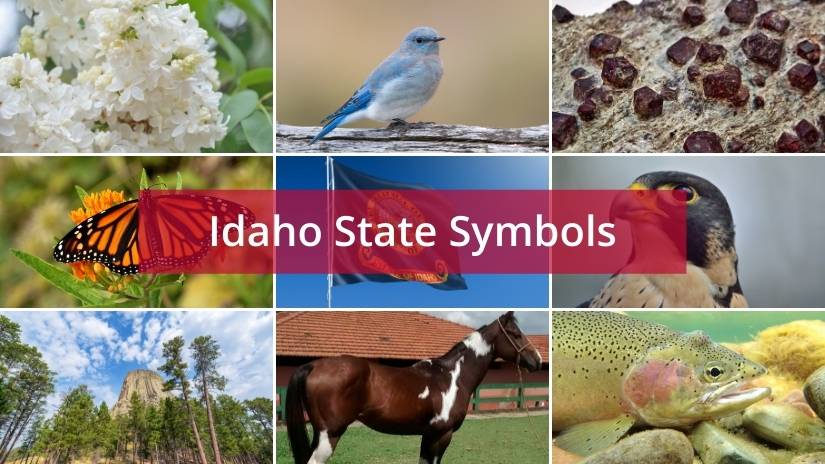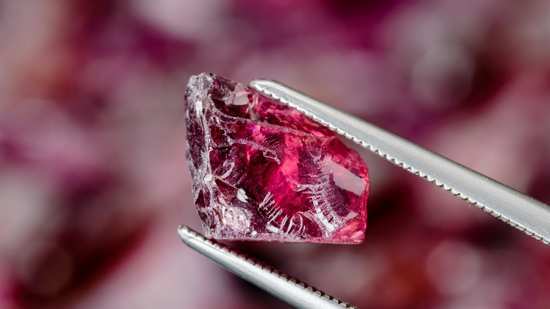State symbols have been a mainstay of U.S. culture for many years. Official symbols are used to represent the cultural heritage and natural history of each state in the most fun way possible.
Idaho is no different from many other U.S. states and it has an abundance of fantastic symbols that are indicative to the state’s historical roots and geological history. There are also recognizable icons and emblems for each state, such as state seals and flags, nicknames and mottos, trees and fruits, and much more which are all included in our Idaho state symbol list.

Idaho’s State Symbols List
There are an incredible amount of Idaho state symbols which creates a whole host of interesting facts, both from the past and present. We have shortlisted the top 6 most significant Idaho state symbols below and further down the page you will find a comprehensive table with each Idaho symbol and the date they were officially created.
Idaho State Fish
The cutthroat trout became the official Idaho state fish in 1990. These incredibly unique-looking freshwater fish can be found in rivers and streams across the state, and the rest of North America. The water conditions, however, must be cool, clean, and pure. Cutthroat trouts represent many other states as their state fish or animal too.

In Idaho, you will likely come across two different species of cutthroat trout, the Westslope cutthroat, which can be found in north and central Idaho, and the Yellowstone cutthroat, which typically resides in southeastern Idaho. These beautiful fish have adopted their name due to, you guessed it, the distinctive red slash under their lower jaw, resembling a cutthroat!
Idaho State Fruit
The huckleberry is a pretty popular fruit around the entire nation, with many people choosing them to bake tasty treats such as pies, muffins, and pastries. It became the official state fruit of Idaho in 2000 after fourth-grade students from Southside Elementary School suggested the adoption of the huckleberry as Idaho’s state fruit.

Idaho State Bird and Flower
The gorgeous mountain bluebird (Sialia arcticia) has been the official Idaho state bird since 1931, the bluebird is also recognized as the official state raptor. Bluebirds are found in abundance all across the state of Idaho, typically residing in the mountain ranges. Additionally, they are found over the U.S. and North America on ranch land and farmland.

The syringa (Philadelphus lewisii) was chosen to be the state flower symbol of Idaho in 1931, which was the same year that Idaho adopted the state bird symbol too. This beautiful flower is a woody shrub that is covered in white clusters, occasionally taking up an orange coloration. They typically grow to around 10 feet tall. Both the Idaho state bird and flower are powerful representations of the state, both past and present.
Idaho State Seal
The majority of the famous Idaho state seal is actually an updated painting by Emma Edwards Green, the painting was selected as the design of the state seal by the state of Idaho in 1891, which was one year after the state declared its official independence, and subsequently becoming a state.

The text below has been quoted by Emma Edwards Green when asked what the meaning of the famous Idaho state seal is:
“Before designing the seal, I was careful to make a thorough study of the resources and future possibilities of the State. I invited the advice and counsel of every member of the Legislature and other citizens qualified to help in creating a Seal of State that really represented Idaho at that time. Idaho had been admitted into the Union on July 3rd, 1890. The first state Legislature met in Boise on December 8, 1890, and on March 14, 1891, adopted my design for the Great Seal of the State of Idaho.”
Idaho State Insect
Monarch butterflies (Danaus plexippus) have been the official Idaho state insect since 1992. The insect has been adopted thanks to the efforts of 4th-grade students studying at Boise’s Cole Elementary School! However, Idaho is not the only state to adopt this as their official insect, 6 other states have done the same (AL, IL, MN, TX, VT, WV)!

Idaho State Tree
The western white pine (Pinus Monticola pinaceae) became the official state tree of Idaho in 1935. Northern Idaho hosts the best and most beautiful white Pinetree forests, deep in the Coeur d’Alene and Bitterroot Mountains, these breathtaking pines can be found in abundance.

Idaho State Stone
The star garnet is the official state stone of Idaho and has been since 1967. Considered to be even more valuable and precious than rubies or star sapphires, the star garnet typically takes up a dark purple appearance, with four rays, resembling a star.

All Idaho State Symbols (Table)
Now that we have taken a look at some of the more popular and notable state symbols that are associated with the state of Idaho, it makes sense to showcase all the Idaho state symbols that are best used to represent the state’s history and more present achievements and moments. Here is the complete list of symbols:
| Type Of Symbol | State Symbol | Year |
|---|---|---|
| Idaho State Amphibian | Idaho Giant Salamander | 2015 |
| Idaho State Bird | Mountain Bluebird | 1931 |
| Idaho State Fish | Cutthroat Trout | 1990 |
| Idaho State Flag | Civil and State Flag | 1907 |
| Idaho State Flower | Syringa | 1931 |
| Idaho State Fossil | Hagerman horse fossil | 1988 |
| Idaho State Fruit | Huckleberry | 2000 |
| Idaho State Seal | Seal of the State of Idaho | 1891 |
| Idaho State Horse | Appaloosa | 1975 |
| Idaho State Insect | Monarch Butterfly | 1992 |
| Idaho State Language | English | 2007 |
| Idaho State Raptor | Peregrine Falcon | 2004 |
| Idaho State Song | "Here We Have Idaho" | 1931 |
| Idaho State Stone | Star Garnet | 1967 |
| Idaho State Tree | White Pine | 1935 |
| Idaho State Vegetable | Potato | 2002 |


